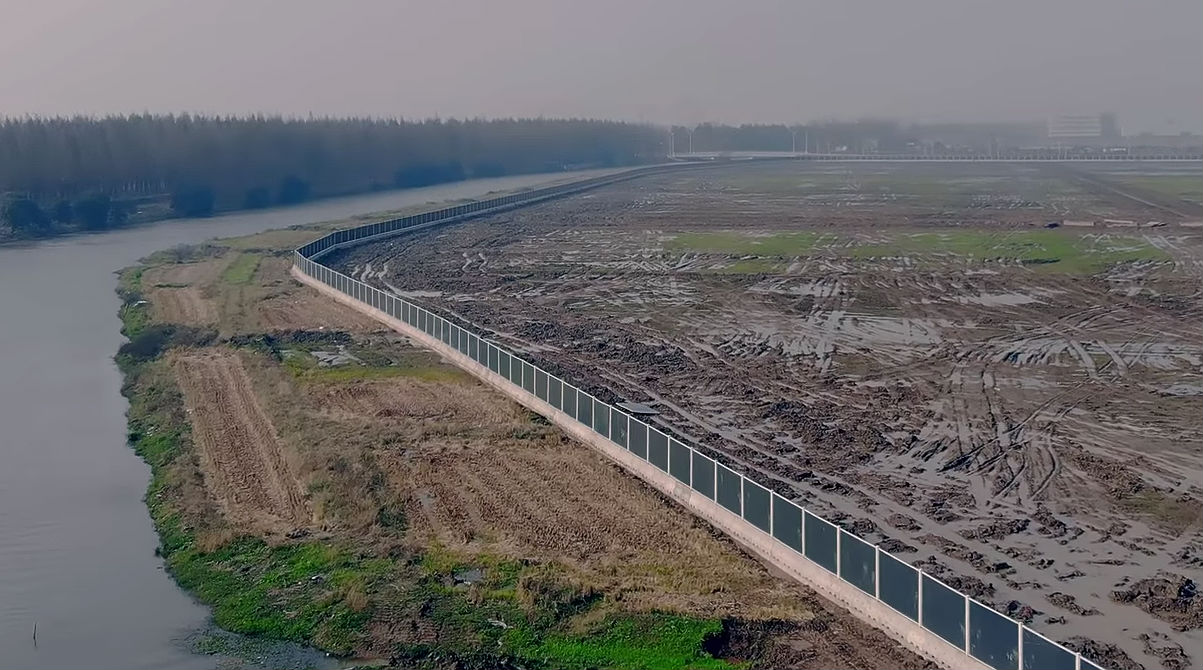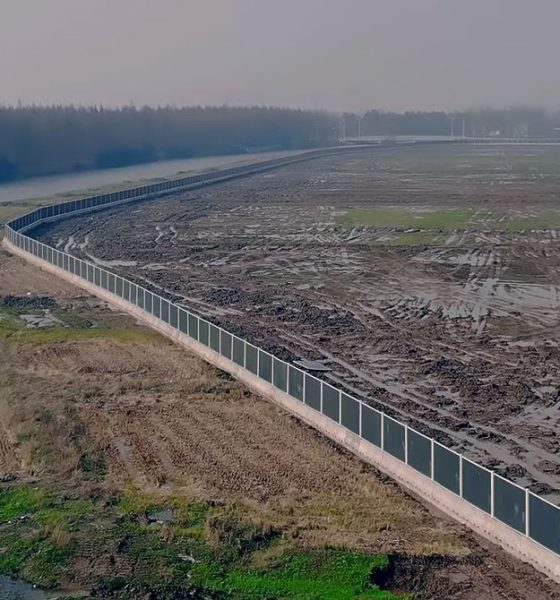

News
Tesla Gigafactory 3 construction in China begins with rapid buildout of perimeter fence
Tesla’s Gigafactory 3 in Shanghai is beginning to take shape, with construction work on the facility entering its first phases. Drone footage taken last Wednesday, for one, recently revealed that workers have seemingly finished laying a perimeter fence around Tesla’s 864,885-square meter plot of land in Shanghai’s Lingang Industrial Zone, paving the way for more work to be done.
The drone footage of Gigafactory 3’s perimeter fence comes just over a week after Shanghai Mayor Ying Yong and Vice Mayor Wu Qing met with Tesla’s leaders in China to check out the company’s new vehicles like the Model 3. During their visit, the officials urged Tesla and other parties involved in the facility’s construction to expedite the buildout of Gigafactory 3.
Tesla’s timeframe for Gigafactory 3 has always been ambitious. When the company initially announced that it plans to start vehicle production in the facility roughly two years after the site’s construction begins, many were dismissive. Tesla critics were quick to note that such a timeframe is too ambitious. Wall Street was equally skeptical, with Consumer Edge Research senior auto analyst James Albertine dubbing Gigafactory 3’s timeline as simply “not feasible.”
Tesla, for its part, eventually opted to change its initial timeline for the facility. Instead of taking a more conservative stance, though, Tesla did the opposite, stating in its Q3 2018 vehicle production and deliveries report that it would be accelerating the construction of Gigafactory 3 even more. Tesla further noted that it expects the project to be a “capital efficient and rapid buildout, using many lessons learned from the Model 3 ramp in North America.”
While the timeframe for Gigafactory 3 is undoubtedly ambitious, the company does enjoy the favor of the Chinese government, allowing Tesla to tap into local resources and manpower. Seemingly as a response to questions about Tesla’s ability to gain funding for the project, for example, reports emerged that local Shanghai banks have given the electric car maker low-interest loans amounting to 30% of the factory’s estimated costs. Tesla’s bid for the 864,885-square meter plot of land also went unchallenged, enabling the company to quickly prepare for the facility’s construction. With this in mind, it appears that the rapid buildout of Gigafactory 3’s perimeter fence is simply yet another sign that the government fully supports the project.
Chinese Media: After Tesla China announced the new pricing structure of Model S and X, many potential customers rush to their nearest Tesla stores to check out the vehicles, many of them were ordered right at the stores, demand largely increased. $TSLA #Tesla #China #TeslaChina pic.twitter.com/NnYUbvsbg4
— vincent (@vincent13031925) December 16, 2018
Gigafactory 3 will play a considerable role in Tesla’s expansion into the Chinese market. By producing vehicles locally, Tesla would be able to avoid the import tariffs placed on its vehicles coming from the United States, while allowing Tesla to release competitively priced cars to go against lower-priced EVs being produced by local carmakers.
China stands as the world’s largest market for electric cars, being a country that is aggressively pushing for sustainable transportation. With this in mind, Tesla’s success in the country would likely be dependent on how it could target the greater Chinese auto industry with its lower-priced vehicles. While the Model S and Model X are mostly seen as status symbols for the successful and wealthy, the luxury sedan and SUV nonetheless cater to the country’s upper class, which represents a much smaller market. With vehicles such as the Model Y and the Model 3 saturating the country from Gigafactory 3, Tesla could tap into China’s ever-growing mainstream electric car market, which is on pace to hit a milestone of 1 million EVs sold in 2018.
Watch the progress of Gigafactory 3 in the video below.
https://youtu.be/rx3mXjQg46U

Elon Musk
Elon Musk’s X will start using a Tesla-like software update strategy
The initiative seems designed to accelerate updates to the social media platform, while maintaining maximum transparency.

Elon Musk’s social media platform X will adopt a Tesla-esque approach to software updates for its algorithm.
The initiative seems designed to accelerate updates to the social media platform, while maintaining maximum transparency.
X’s updates to its updates
As per Musk in a post on X, the social media company will be making a new algorithm to determine what organic and advertising posts are recommended to users. These updates would then be repeated every four weeks.
“We will make the new 𝕏 algorithm, including all code used to determine what organic and advertising posts are recommended to users, open source in 7 days. This will be repeated every 4 weeks, with comprehensive developer notes, to help you understand what changed,” Musk wrote in his post.
The initiative somewhat mirrors Tesla’s over-the-air update model, where vehicle software is regularly refined and pushed to users with detailed release notes. This should allow users to better understand the details of X’s every update and foster a healthy feedback loop for the social media platform.
xAI and X
X, formerly Twitter, has been acquired by Elon Musk’s artificial intelligence startup, xAI last year. Since then, xAI has seen a rapid rise in valuation. Following the company’s the company’s upsized $20 billion Series E funding round, estimates now suggest that xAI is worth tens about $230 to $235 billion. That’s several times larger than Tesla when Elon Musk received his controversial 2018 CEO Performance Award.
As per xAI, the Series E funding round attracted a diverse group of investors, including Valor Equity Partners, Stepstone Group, Fidelity Management & Research Company, Qatar Investment Authority, MGX, and Baron Capital Group, among others. Strategic partners NVIDIA and Cisco Investments also continued support for building the world’s largest GPU clusters.
News
Tesla FSD Supervised wins MotorTrend’s Best Driver Assistance Award
The decision marks a notable reversal for the publication from prior years, with judges citing major real-world improvements that pushed Tesla’s latest FSD software ahead of every competing ADAS system.

Tesla’s Full Self-Driving (Supervised) system has been named the best driver-assistance technology on the market, earning top honors at the 2026 MotorTrend Best Tech Awards.
The decision marks a notable reversal for the publication from prior years, with judges citing major real-world improvements that pushed Tesla’s latest FSD software ahead of every competing ADAS system. And it wasn’t even close.
MotorTrend reverses course
MotorTrend awarded Tesla FSD (Supervised) its 2026 Best Tech Driver Assistance title after extensive testing of the latest v14 software. The publication acknowledged that it had previously criticized earlier versions of FSD for erratic behavior and near-miss incidents, ultimately favoring rivals such as GM’s Super Cruise in earlier evaluations.
According to MotorTrend, the newest iteration of FSD resolved many of those shortcomings. Testers said v14 showed far smoother behavior in complex urban scenarios, including unprotected left turns, traffic circles, emergency vehicles, and dense city streets. While the system still requires constant driver supervision, judges concluded that no other advanced driver-assistance system currently matches its breadth of capability.
Unlike rival systems that rely on combinations of cameras, radar, lidar, and mapped highways, Tesla’s FSD operates using a camera-only approach and is capable of driving on city streets, rural roads, and freeways. MotorTrend stated that pure utility, the ability to handle nearly all road types, ultimately separated FSD from competitors like Ford BlueCruise, GM Super Cruise, and BMW’s Highway Assistant.
High cost and high capability
MotorTrend also addressed FSD’s pricing, which remains significantly higher than rival systems. Tesla currently charges $8,000 for a one-time purchase or $99 per month for a subscription, compared with far lower upfront and subscription costs from other automakers. The publication noted that the premium is justified given FSD’s unmatched scope and continuous software evolution.
Safety remained a central focus of the evaluation. While testers reported collision-free operation over thousands of miles, they noted ongoing concerns around FSD’s configurable driving modes, including options that allow aggressive driving and speeds beyond posted limits. MotorTrend emphasized that, like all Level 2 systems, FSD still depends on a fully attentive human driver at all times.
Despite those caveats, the publication concluded that Tesla’s rapid software progress fundamentally reshaped the competitive landscape. For drivers seeking the most capable hands-on driver-assistance system available today, MotorTrend concluded Tesla FSD (Supervised) now stands alone at the top.
News
Elon Musk’s Grokipedia surges to 5.6M articles, almost 79% of English Wikipedia
The explosive growth marks a major milestone for the AI-powered online encyclopedia, which was launched by Elon Musk’s xAI just months ago.

Elon Musk’s Grokipedia has grown to an impressive 5,615,201 articles as of today, closing in on 79% of the English Wikipedia’s current total of 7,119,376 articles.
The explosive growth marks a major milestone for the AI-powered online encyclopedia, which was launched by Elon Musk’s xAI just months ago. Needless to say, it would only be a matter of time before Grokipedia exceeds English Wikipedia in sheer volume.
Grokipedia’s rapid growth
xAI’s vision for Grokipedia emphasizes neutrality, while Grok’s reasoning capabilities allow for fast drafting and fact-checking. When Elon Musk announced the initiative in late September 2025, he noted that Grokipedia would be an improvement to Wikipedia because it would be designed to avoid bias.
At the time, Musk noted that Grokipedia “is a necessary step towards the xAI goal of understanding the Universe.”
Grokipedia was launched in late October, and while xAI was careful to list it only as Version 0.1 at the time, the online encyclopedia immediately earned praise. Wikipedia co-founder Larry Sanger highlighted the project’s innovative approach, noting how it leverages AI to fill knowledge gaps and enable rapid updates. Netizens also observed how Grokipedia tends to present articles in a more objective manner compared to Wikipedia, which is edited by humans.
Elon Musk’s ambitious plans
With 5,615,201 total articles, Grokipedia has now grown to almost 79% of English Wikipedia’s article base. This is incredibly quick, though Grokipedia remains text-only for now. xAI, for its part, has now updated the online encyclopedia’s iteration to v0.2.
Elon Musk has shared bold ideas for Grokipedia, including sending a record of the entire knowledge base to space as part of xAI’s mission to preserve and expand human understanding. At some point, Musk stated that Grokipedia will be renamed to Encyclopedia Galactica, and it will be sent to the cosmos.
“When Grokipedia is good enough (long way to go), we will change the name to Encyclopedia Galactica. It will be an open source distillation of all knowledge, including audio, images and video. Join xAI to help build the sci-fi version of the Library of Alexandria!” Musk wrote, adding in a later post that “Copies will be etched in stone and sent to the Moon, Mars and beyond. This time, it will not be lost.”








